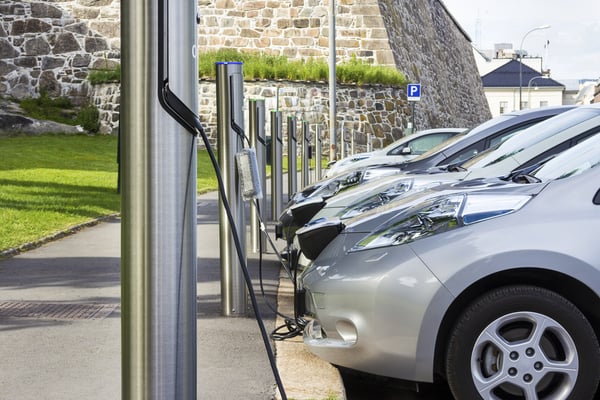Electric Vehicles: Opportunities and Challenges

Electric vehicles (EV) are a promising technology, since they can drastically cut emissions from the transportation sector. In urban areas, only buildings produce more emissions than vehicles. However, vehicles release all their emissions locally, while a large portion of building emissions is indirect, occurring at power plants. Transportation is the main source of air pollution in cities, even if building emissions are larger overall.
Even if EVs connect to a power grid that relies on fossil fuels, cities benefit from an improvement in air quality. In this case, emissions are moved away from streets and buildings, and concentrated at power plants. Of course, using clean power to charge EVs is the best option, since this can improve air quality while eliminating emissions completely.
Are you considering EV chargers for your building?
Economic and Environmental Benefits of Electric Vehicles
On average, electric vehicles are more expensive than their fuel-burning counterparts. However, since solar and wind power have become so cheap, an EV that runs with them can achieve a very low operating cost.
Also consider that each EV contains a high-performance battery, and units that are connected to the grid can accumulate a considerable storage capacity. Utility companies can negotiate with EV owners to take advantage of this resource:
- When there is surplus electricity generation in the grid, connected EVs can be instructed to start charging. Electricity prices drop when there is surplus generation, and EV owners also benefit from cheap charging in this case.
- The opposite also applies: Power companies can aggregate the storage capacity of connected EVs and other energy storage systems to manage peaks in demand better. Of course, EV owners that participate in a program like this must first agree to have charge taken from their batteries. A viable option is offering EV owners compensation for supplying electricity during high-demand periods.
A promising concept is creating a “virtual power plant” that aggregates the storage capacity of EVs and other battery systems connected to the grid. This way, the total capacity acts a single resource, even when individual EVs are being connected and disconnected all the time.

EVs also help eliminate indirect emissions, since distributing electricity to EV chargers is much more efficient than distributing fuel to gas stations. Fuel deliveries require tanker trucks, which consume even more fuel for distribution. On the other hand, a well-serviced power grid can deliver electricity to charging stations with minimal losses.
The environmental benefits of EVs are evident during heavy traffic. A combustion engine always burns fuel, even when idling. However, EVs can recover charge with regenerative braking, and the emissions from idling are eliminated.
When the concept of an electric vehicle is mentioned, we tend to visualize a sedan or a sports car. However, the broader concept of “electric mobility” has recently gained popularity. Electric power can move vehicles of all types, ranging from scooters and bicycles to buses and trailers.
Main Challenges When Deploying Electric Vehicles
In spite of their environmental benefits, electric vehicles also bring unique challenges. First of all, a city must have a network of EV charging stations to support a large fleet. EV owners normally have residential chargers, but these units are slow and the vehicle must be left plugged in overnight. EVs are only parked for short periods in many commercial spaces, and only DC fast chargers are viable in these cases.
Widespread use of EVs can also change the load profile on electricity grids, especially if a city has many DC fast chargers - many models consume up to 50 kilowatts.
- Currently, power grids tend to experience their highest annual demand on hot summer days, when there are thousands of air conditioning systems running at full capacity.
- If a demand peak from EV chargers matches a demand peak from air conditioners, existing grids may not be able to handle the load, making blackouts more likely.
There is no demand peak from air conditioning during winter, but the demand peak from EV chargers can combine with that of heat pumps - another emerging technology. The combination of electric vehicles and heat pumps can greatly reduce emissions from cities, but careful planning is very important to avoid an excessive burden on the power grid.

Michael Tobias
Michael Tobias, the Founding Principal of NY Engineers, currently leads a team of 150+ MEP/FP engineers and has led over 4,000 projects in the US
Join 15,000+ Fellow Architects and Contractors
Get expert engineering tips straight to your inbox. Subscribe to the NY Engineers Blog below.

